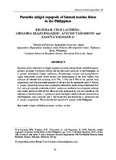Parasitic caligid copepods of farmed marine fishes in the Philippines
- Global styles
- MLA
- Vancouver
- Elsevier - Harvard
- APA
- Help
Share
抄録
Recently, heavy infestation of caligid copepods occurred among farmed rabbitfish Siganus guttatus, pompano Trachinotus blochii and sea bass Lates calcarifer in the Philippines. In S. guttatus broodstock, Caligus epidemicus, Pseudocaligus uniartus and Lepeophtheirus sigani concurrently caused severe erosion and hemorrhaging of the body surface, fins and eyes of affected fish occurring at 95.78%, 1.52% and 0.70% of the parasite load, respectively, and with associated mortality of the host fish. In marketable-sized T. blochii, L. spinifer caused body lesions that considerably reduced the market value of harvested fish. In L. calcarifer juveniles, infestation with C. epidemicus resulted to loss of appetite, lethargy and stunted growth of affected fish. Because of its pathogenicity, low host specificity and tolerance to brackish water, C. epidemicus poses the highest threat to farmed marine fish in the Philippines. Lates calcarifer and T. blochii are new host records for C. epidemicus and L. spinifer, respectively. This is also the first record of L. spinifer in the Philippines.
Suggested Citation
Cruz-Lacierda, E. R., Erazo-Pagador, G., Yamamoto, A., & Nagasawa, K. (2011). Parasitic caligid copepods of farmed marine fishes in the Philippines. In M. G. Bondad-Reantaso, J. B. Jones, F. Corsin, & T. Aoki (Eds.), Diseases in Asian Aquaculture VII (pp. 53–62). Selangor, Malaysia: Fish Health Section, Asian Fisheries Society.
Type
Conference paperCollections
- Conference Proceedings [299]


